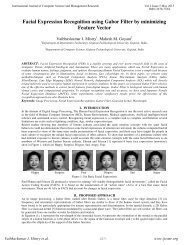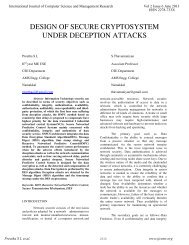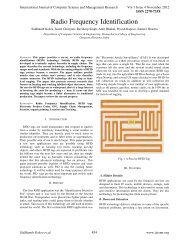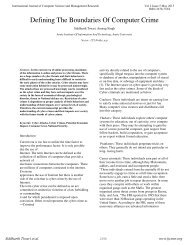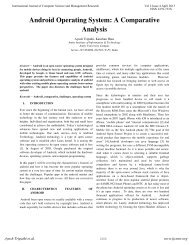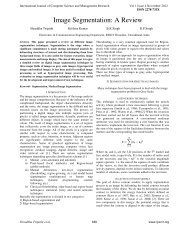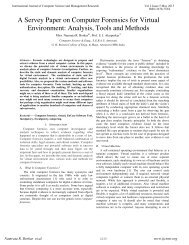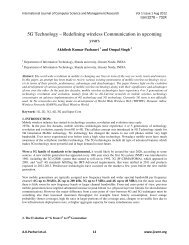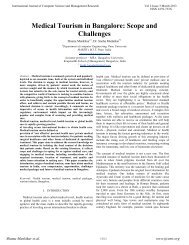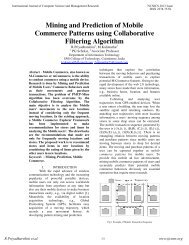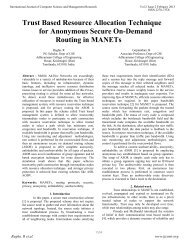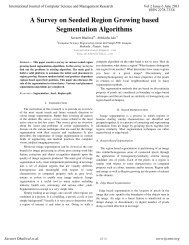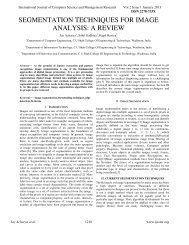A Square Root Topologys To Find Unstructured Peer-To ... - ijcsmr
A Square Root Topologys To Find Unstructured Peer-To ... - ijcsmr
A Square Root Topologys To Find Unstructured Peer-To ... - ijcsmr
- No tags were found...
You also want an ePaper? Increase the reach of your titles
YUMPU automatically turns print PDFs into web optimized ePapers that Google loves.
International Journal of Computer Science and Management Research Vol 2 Issue 3 March 2013ISSN 2278-733Xevaluated keyword queries against the web pages.Then we generated 20,000 synthetic queriesmatching 631,320 synthetic documents, stored at20,000 peers, such that the statistical properties ofour synthetic content model matched those of thereal trace. The resulting content model allowed usto simulate a network of 20,000 peers. In thissimulation, we submitted random queries chosenfrom the set of 20,000 to produce a total of 100,000query submissions. we describe the details of thismethod of generating synthetic documents andqueries, and provide experimental evidence that thecontent model, though synthetic, results in highlyaccurate simulation results. The synthetic modelretains an accurate distribution of the popularity ofpeer content, which is critical for the construction ofthe square-root topology.3.2 Random walksWe conducted an experiment to examine theperformance of random walk searches in differenttopologies. This queries matched documents storedat different peers, and had a goal G = 10 results. Wecompared three different topologies.• A square-root topology, generated by assigning adegree to each peer based on equation (2), and thencreating links between randomly chosen pairs ofpeers based on the assigned degrees.• A low-skew power-law topology, generated usingthe PLOD algorithm . In this network, α = 0.58.• A high-skew power-law topology, generated usingthe PLOD algorithm, with α = 0.74.Random walks in the square-root topology require8,940 messages per search, 26 percent less. thanrandom walks in the low-skew power-law topologyand 45 percent less than random walks in the highskewpower-law topology. In the power-lawtopologies, searches tend toward high degree peers,even if the walk is truly random and not explicitlydirected to high degree peers. These high degreepeers also have the most popular content, Result isthat searches have a low probability of going to thepeer with matching content, and the number of hopsand thus messages increases. If the power-lawdistribution is more skewed, then the probabilitythat searches will congregate at the wrong peers ishigher and the total number of messages arenecessary to get to the right peers increases. Eventhough random walks perform best in the squareroottopology, a large number of messages need tobe sent. the result is a significant improvement overtraditional Gnutella style search, flooding in a highskewpower-law network, with a TTL of five inorder to find at least ten results on average, requires17,700 messages per search. The above results arefor simple, unoptimized random walks. Addingoptimizations such as proactive replication orneighbor indexing reduces the cost of a randomwalk search, and results for these techniques showthat the square-root topology is still best. Anotherissue with random walks is that the search latency ishigh, as queries may have to walk many hopsbefore finding content. <strong>To</strong> deal with this, Lv et alpropose creating multiple, parallel random walksfor each search. Since the network processes thesewalks in parallel, the result is reduced searchlatency. We ran experiments where we created 2,10,15, 20, 30, and 100 parallel random walks for eachsearch, and measured search latency.Walks<strong>Square</strong>rootPower-lawPower lawlow-skewhigh-skew1 8930 12090 163502 4500 6210 89705 1800 2490 374010 904 1250 188020 454 630 947100 96 130 194Table2. Parallel random walks: search latency(ticks).These results are shown in Table 2.Thesquare-root topology provided the lowest searchlatency, regardless of the number of parallel walksthat were generated. The improvement for thesquare-root topology was consistently 27 percentcompared to the low-skew power-law topology, and50 percent compared to the high-skew power-lawtopology. Even when searches are walking inparallel, the square root topology helps those searchwalks quickly arrive at the peers with the rightcontent.3.3 Proactive ReplicationThe square-root topology is complementary to thesquare-root replication. It is feasible to proactivelyreplicate content, the square-root replicationspecifies that the number of copies made of contentshould be proportional to the square root of thepopularity of the content. The square-root topologycan be used whether or not proactive replication isused, the combination of the two techniques canprovide significant performance benefits. Weconducted an experiment where Replicated contentaccording to the square-root replication. Then weconnected peers in the square-root, high-skewpower-law, and low-skew power-law topologies,and states the performance of random walksearches. Again, G= 10. As expected, proactiveD. Raman et.al. 1734www.<strong>ijcsmr</strong>.org




